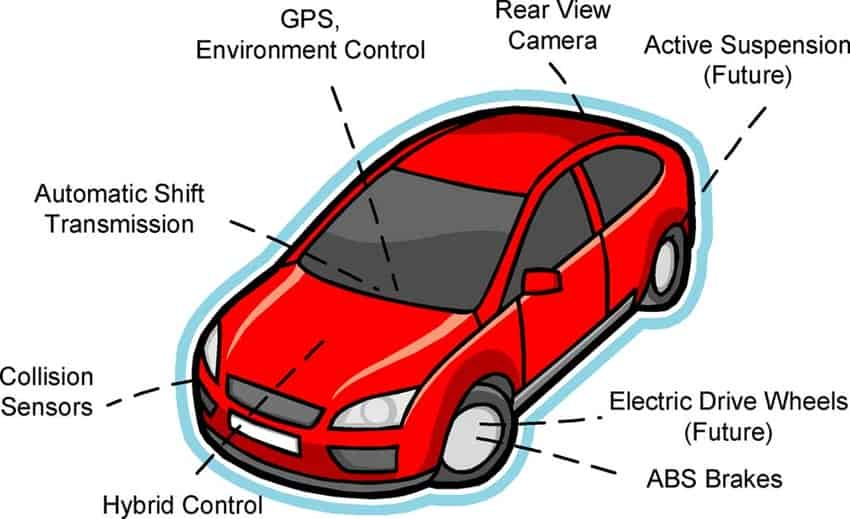

The Evolution of Safety Features in Automobiles: From Luxury to Necessity
In the ever-evolving landscape of automotive technology, safety features have emerged as a pivotal component, transforming from a luxurious add-on to an imperative necessity. Over the years, the automotive industry has witnessed a remarkable shift towards prioritizing driver and passenger safety through innovative advancements. This article delves into the Safety Features in Automobiles, with a particular focus on automatic emergency braking and blind-spot monitoring, shedding light on how they might one day become standard in all vehicles.
The Transition to Mandatory Backup Cameras
Not too long ago, backup cameras were considered a luxury in the world of automobiles. These rear-view cameras were often relegated to higher trim levels, compelling consumers to spend extra money for a glimpse into their vehicle’s blind spot. However, as technology advanced and concerns for road safety heightened, the landscape changed dramatically. The pivotal moment arrived when backup cameras ceased to be optional extras and became mandatory on all vehicles. This shift marked a significant step towards enhancing safety on the roads.
The Drive Towards Standardization
The advancement of technology in the automotive industry continues to redefine our driving experience. As vehicles become more innovative, they strive to provide us with the safest possible journey. It is only logical that essential safety features, once considered add-ons, should evolve into standard inclusions.
Automatic Emergency Braking: A Game-Changer
Automatic emergency braking, a prominent active safety feature, has gained immense popularity in modern cars. Its primary function involves intervening in emergency situations by applying the brakes when necessary. This system operates with remarkable speed, far surpassing human reflexes, potentially saving drivers from rear-end collisions.
Despite its undeniable safety benefits, automatic emergency braking is not yet a universal standard across all vehicles. Prospective car buyers must check if the specific trim level they desire offers this life-saving feature. Adjusting to a vehicle that can independently control acceleration and braking can take some getting used to for many drivers. Yet, its potential to prevent accidents and save lives is undeniable.
Blind-Spot Monitoring: Enhancing Confidence
Another groundbreaking safety feature that demands our attention is blind-spot monitoring. This system, though initially requiring an adjustment period, quickly becomes indispensable once experienced. It empowers drivers to change lanes confidently and safely by alerting them to vehicles or obstacles lurking in their blind spots.
Blind spots have long been a thorn in the side of many drivers, especially those operating older cars, sports cars, or convertibles. Blind-spot monitoring significantly elevates the driving experience and contributes to overall road safety by mitigating the risks associated with lane changes and merging.
The Path to Standardization
Several standard safety features have already become ubiquitous in newly manufactured vehicles, a transformation driven by consensus on their critical role in enhancing public and road safety. These once-optional features have now become non-negotiable inclusions, setting the stage for more safety advancements.
Seat Belts and Airbags: A Historical Perspective
Two fundamental safety features, seat belts, and airbags, serve as compelling examples of this evolution. In the past, they were merely optional add-ons in many vehicles, absent in numerous older, classic cars. However, the collaboration between car safety agencies and manufacturers ultimately led to a consensus that these features were paramount for public safety and responsible road use.
The transition from optional extras to standard equipment was driven by a collective commitment to reducing the severity of injuries and fatalities on the road. Today, seat belts and airbags are universal fixtures in vehicles worldwide, saving countless lives and mitigating the consequences of accidents.
Technological Advancements and Standardization
As vehicles continue to embrace technological innovations, safety features such as automatic emergency braking and blind-spot monitoring are on a trajectory towards becoming standard rather than optional extras. This progression mirrors the history of rearview cameras, which were once considered a luxury in certain vehicles but were subsequently federally mandated for installation in all newly manufactured vehicles.
The Future of Safety Features
The pace of technological innovation in the automotive industry shows no signs of slowing down. The question that remains is whether safety features like automatic emergency braking and blind-spot monitoring will become standard in all new vehicles. While it is not guaranteed, history suggests that as technology proves its worth in enhancing road safety, it is increasingly likely that these features will one day become universal requirements.
In conclusion, the transformation of safety features in automobiles, from luxury add-ons to essential components, is a testament to the industry’s commitment to enhancing driver and passenger safety. As technology continues to advance, safety features that were once optional extras are steadily becoming standard inclusions. While the future remains uncertain, the trajectory is clear: the automotive industry is evolving towards a safer, more secure driving experience for all.
Add a comment Cancel reply
Comments (0)
Categories
- Biography (4)
- Car Reviews (31)
- Car Tips (53)
- Classic Cars (45)
- Net Worth (12)
- Transportation (19)
Recent Posts
Related posts


Top 5 Reliable Car Dealerships in Lagos: Your Ultimate Guide

How to Buy a Tokunbo Car in Nigeria Without Getting Scammed








